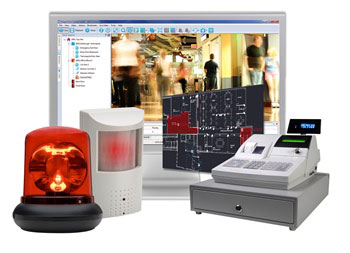
Identifying and solving data bottlenecks in your Surveillance Network
Simon Steer is an IndigoVision surveillance expert with over 16 years helping companies implement efficient, scalable networks. Here he takes a look at some of the causes of data bottlenecks and how to solve them.
How are data bottlenecks in a surveillance network caused?
Higher megapixel cameras, higher bitrates, more cameras, more users and the need for instantaneous availability of data can cause data bottlenecks.
User response times and the number of Operators and Administrators have a direct impact on data flow. As the number of Operators and Administrators increases, the probability for them interfering with each other increases. Also, the physical location of these users is important. If there is a central control room, then the data flow is concentrated into that room. If there are multiple control rooms, the data flow across the network has a different pattern and the flow between these remote control rooms becomes very important.
There can be multiple data bottlenecks in a surveillance network but typically the location and I/O of the NVRs or the network infrastructure can cause data bottlenecks.
What is the impact of data bottlenecks?
Day to day impacts of data bottlenecks for Operators are:
- The time it takes to log into the security management system.
- The time it takes to start seeing live video after selecting a camera.
- The time it takes for a PTZ camera to move following a command.
- The time it takes to clear an alarm.
Day to day impacts of data bottlenecks for Administrators are:
- The time it takes to add or delete a camera, user or alarm detector from the site.
- The time it takes between adding a new user and that user being able to log in.
- The time it takes for changes made by one Administrator to be seen by other Administrators.
More serious impacts can be loss of live video, inability to recall playback and loss of recordings.
How can you solve data bottlenecks?
Just adding more technology to the solution will not solve data bottlenecks.
Higher capacity networks will allow more connections to be made. These are important tools in scaling a system but they cannot solve all scalability issues. When systems scale to hundreds of users, thousands of cameras, tens of thousands of alarm inputs; you have to adopt organisational tools as well as technology tools. The answer could be to segment and distribute the security system.
This is similar to how large organisations segment and distribute their man-management. No one manager has the capacity to manage thousands of employees. Organisational structures are required, based usually on a combination of geography (location of employees) and team responsibilities (employees that work in the same team or project).
In a security system, the equivalent of these organisational tools is segmented sites and solid network architecture.
Example of how to solve a data bottleneck in a surveillance network
There were three core fixes for this:
- Move secondary site Video storage to the secondary site, i.e. diversify the NVR locations, reducing video traffic over the microwave link
- Upgrade the microwave link so there was more capacity - went from a 150Mbps to a 300Mbps
- Introduce a diverse link, a private wire, to increase connectivity and provide a redundant link if there were any network failures
Why use Segmented Sites?
This is the key to facilitate the scalability of very large systems. By segmenting the site into different groupings and sub-groupings, the data flow associated with operating and administering the overall site becomes segmented as well.
The structure of the system must be organised into manageable groups of cameras, manageable groups of users and manageable sets of permissions.
An operator who is responsible for the entrance and exit of a high profile building or a particular store in a shopping centre doesn't need access to the video and alarms from other parts of the system. In fact, it is important that they aren't distracted by the other parts of the system.
Of course, a supervisor may need an overview of the whole system or be able to receive escalated alarms from sub-sites within the system but there are far fewer supervisors requiring access to the whole system than operators requiring access to portions of the system.
Segmenting sites has the dual effect of reducing data overload to users and reducing data bottlenecks within the network.
Contact IndigoVision about your security systems
If you think your organisation could benefit from updating its security systems, contact IndigoVision today








